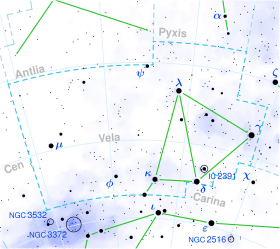Delta Velorum
| Observation data Epoch J2000 Equinox J2000 |
|
|---|---|
| Constellation | Vela |
| δ Vel A | |
| Right ascension | 08h 44m 42.226s |
| Declination | −54° 42′ 31.76″ |
| Apparent magnitude (V) | 1.99(1.99 - 2.39) |
| δ Vel B | |
| Right ascension | 08h 44m 42.203s |
| Declination | −54° 42′ 30.60″ |
| Apparent magnitude (V) | 5.57 |
| Characteristics | |
| U−B color index | +0.07 |
| B−V color index | +0.04 |
| δ Vel A | |
| Spectral type | A1 Va(n) |
| Variable type | Eclipsing binary |
| δ Vel B | |
| Spectral type | F2-F5 |
| Astrometry | |
| Radial velocity (Rv) | +2.2 km/s |
| Proper motion (μ) |
RA: +28.99 mas/yr Dec.: −103.35 mas/yr |
| Parallax (π) | 40.49 ± 0.39mas |
| Distance | 80.6 ± 0.8 ly (24.7 ± 0.2 pc) |
| Absolute magnitude (MV) | 0.02/3.60 |
| Details | |
| δ Vel A | |
| Mass | 2.53/2.37 M☉ |
| Radius | 2.643/2.363 R☉ |
| Luminosity | 56.3/47.1 L☉ |
| Surface gravity (log g) | 3.79 cgs |
| Temperature | 9,470/9,370 K |
| Rotational velocity (v sin i) | 150 km/s |
| Age | 400 million years |
| δ Vel B | |
| Mass | 1.5 M☉ |
| Other designations | |
| Database references | |
| SIMBAD | data |
Delta Velorum (δ Vel, δ Velorum) is a star system in the southern constellation Vela, near the border with Carina. Based on parallax measurements, it is approximately 80.6 light-years (24.7 parsecs) from Earth. This star appears in an asterism with the given name of Koo She (Chinese: 弧矢, hú shǐ, "Bow and Arrow"), comprising δ Velorum and ω Velorum.
The south celestial pole will pass close to δ Velorum around 9000 AD because of precession. The False Cross is an asterism formed of the δ Velorum and κ Velorum and ι Carinae and ε Carinae. It is so called because it is sometimes mistaken for the Southern Cross, causing errors in astronavigation.
Delta Velorum is a triple star system. The outward components A and B have a wide orbit with a 142-year orbital period. The primary component A has an apparent magnitude of 1.99, while the secondary component B is magnitude 5.57, with a combined magnitude measured at 1.96. In 1978 the primary component was reported to be a spectroscopic binary in the Proceeding of the Australian Astronomical observatory, and this was confirmed by the Hipparcos satellite. Observations of variability in the δ Velorum system were made independently by ground-based astronomers and the Galileo spaceprobe at Jupiter.
...
Wikipedia

